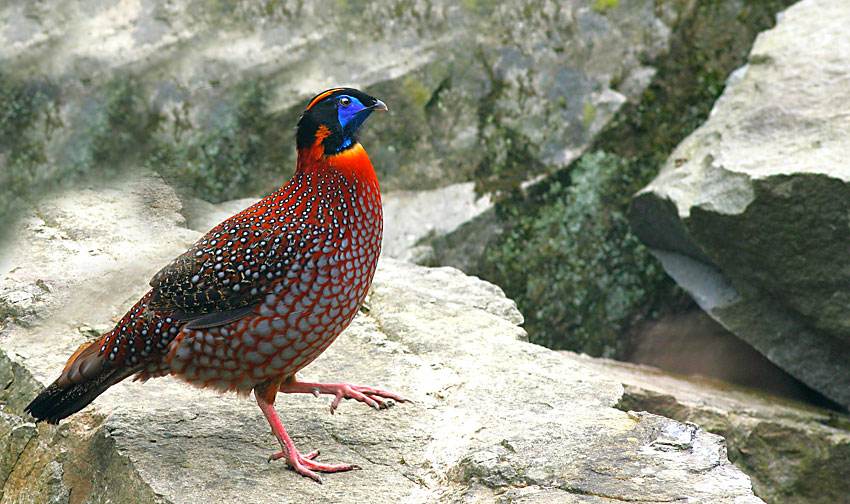Tragopan satyra
IUCN
LCBasic Information
Scientific classification
- name:Tragopan satyra
- Scientific Name:Chaffinch,Tragopan satyra,Satyr Tragopan,Crimson Horned-pheasant,Indian Tragopan
- Outline:Landfowl
- Family:Galliformes Phasianidae Tragopan
Vital signs
- length:57-79cm
- Weight:1-2kg
- lifetime:No verification information
Feature
A gorgeous crimson tragopan native to the Himalayas.
Distribution and Habitat
Distributed in Bhutan, India, Nepal; Tingri, Nyalam, Jilong, Yadong, Nyingchi and the middle section of the Himalayas in southern Tibet, China. Gongshan in northwestern Yunnan.
It lives in mountain forests at an altitude of about 3000-4000 meters, and sometimes goes down to about 2000 meters to hibernate in winter. In China, it is only distributed in the southern and southeastern parts of Tibet at an altitude of 2400-4300 meters. It mainly moves in the steep mountainside forests, and often goes to the open areas on the edge of the forest to move and forage in the morning and evening.
Appearance
The male red-breasted tragopan has a black head and throat, black crown feathers with red tips, body feathers decorated with white pearly dots with black edges, and wings and tail with blue horizontal stripes with yellowish brown. The fleshy horns are blue, and the fleshy neck is also blue. The male bird's head and crest are black, with a red crest tip and a blue fleshy horn on the head; there is a crimson vertical stripe on each side of the crest; the back sides of the head, the back of the neck, the upper back, the shoulders and the small wing coverts are deep crimson; the rest of the upper body, including the lower back, waist, inner wing coverts and the short upper tail coverts are black-brown, with brown-yellow insect-like horizontal spots and white subterminal spots with black edges; the rest of the wing coverts are the same as the back, but with wide crimson feather edges; the wing coverts are brown-yellow with black spots; the flight feathers and primary coverts are black,
Details
The foreign name of the red-breasted tragopan is Satyr Tragopan, and there is no subspecies.

The red-breasted tragopan mainly forages in the early morning and dusk, and likes to hide. Most of the time, it hides in the deep mountains and dense forests where few people go. It is cautious in its movements, good at running, and can fly, but it is not persistent, and the distance it flies each time is not long.
Red-breasted Tragopan mainly feeds on plant food such as roots, buds, leaves, seeds, and bulbs. It especially likes roots and bulbs, and often digs and scratches on the ground. In addition, it also eats insects and small reptiles. Its call is a high and sharp wak call repeated several times. There is also a high call of kya, kya, kya, kya, which sounds like a young goat.
The breeding season of Red-breasted Tragopan is from May to June. During the breeding season, male birds have extremely spectacular show-off behaviors, and sometimes fights occur between male birds to compete for mates. The male bird's courtship show-off process can be divided into 6 steps, and the time required for each step and the characteristics of the flesh skirt are different from those of the Yellow-bellied Tragopan and the Red-bellied Tragopan. The female bird's feeding behavior is stronger than that of the male during the breeding season. The male bird has a stronger territorial behavior during the breeding season. Usually, nesting begins in late April, and the nest is built in the mountain forest at an altitude of about 3,000 meters. The nest is mostly placed on the tree, 0.5-8 meters above the ground. The nest is very hidden, shallow plate-shaped or bowl-shaped, and quite rough and simple. It is mainly composed of branches, vines, three-leaved akebia, usnea, moss and leaves, and is padded with a small amount of pine needles, leaves, weeds and feathers. Each nest lays 2-6 eggs. The color of the eggs is brown-yellow or light yellow, with reddish-brown spots of varying sizes.
The red-breasted tragopan is the most numerous species of tragopan, with an estimated total of about 20,000. However, it is a rare species in China. Some sporadic individuals have been seen in Yadong in southern Tibet and Gongshan in northwestern Yunnan. The number is very rare.
Listed as a rare species in the "China Red Book of Endangered Animals·Birds"
Listed in Appendix III of the "Convention on International Trade in Endangered Fauna and Flora" in 1995
Listed in the "Red List of Endangered Species of the World Conservation Union" (IUCN) 2016 ver 3.1-Near Threatened (NT).
Listed in the first level of China's "National Key Protected Wildlife List" (February 5, 2021).
Protect wild animals and stop eating game.
Maintaining ecological balance is everyone's responsibility!








